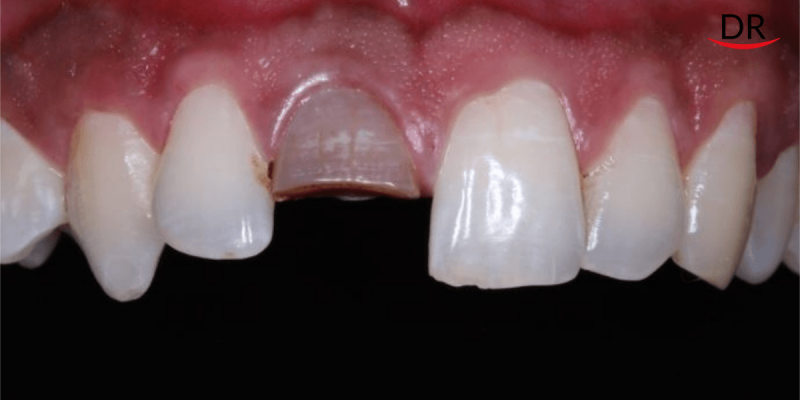CASE REPORT
A 22 year old patient reported to our clinic with discolored and fractured maxillary right central incisor. As he was a front desk official, he was very uncomfortable to speak freely with his customers and hence wanted to get the tooth repaired rather than extracting it.
The real challenge was to get the exact shade match as that of adjacent natural tooth because the discoloration of maxillary right central incisor was long standing. You can learn more about shade matching in a single central incisor here.
On examination, 11 showed discoloration (which was close to C4 Vitapan Classic Shade Guide) and Ellis Class 4 fracture along with a little buccal proclination. The tooth was fractured 10 years ago. The pain on percussion was negative as pulp orifice was open and radiographic examination revealed that 11 had a periapical radiolucency.


The patient was informed about all treatment modalities and finally the treatment plan was –
- Thorough prophylaxis
- Endodontics and restoration of 11, followed by
- Layered zirconia ceramic crown.
According to the plan, 11 was treated endodontically and prepared for walking bleach (Pola Office Plus) to lessen the degree of discoloration. After 2 weeks, the tooth orifice was restored with composite. (A3 body, 3M Z350 and A2 flow). Now the tooth was prepared for the layered zirconia crown , retraction chord (Ultradent 000) was placed in the gingival sulcus for 3 to 4 minutes so that the gingiva moves away from the prepared margins and allows the elastomeric material to record all the details. An elastomeric impression was made (3M ESPE Monophase Soft Polyether) and sent to the laboratory for the further work.


After the labwork was received the crown was tried for its fit intraorally and made ready for further steps of cementation.


For cementation –
- The intaglio surface of the crown was treated with Ivoclean (Ivoclar) for 20 seconds, rinsed with water and then dried.

- The silane coupling agent (Monobond Plus, Ivoclar) was applied and allowed to air dry for 60 seconds.

- Intra orally, the tooth was isolated with rubber dam and etched with 37% phosphoric acid for 15 seconds and dried.


· A dual cure bond (Palifique Universal bond, Tokuyama) was applied on both the prosthesis as well as the tooth.


- The crown was cemented using a dual cure resin cement (Ultimate Relyx 3M), the crown was seated properly and tack cured for 5 seconds and excess was removed.
To know why resin cement was chosen, you can click here.


- The final curing was done through KY Jelly to remove oxygen inhibition layer and thus avoid further staining of resin cement.

After the rubber dam was removed, the working area was cleaned for extra cement patient was allowed to see these end results.



He was extremely happy with his tooth back with the same color and natural form as that of adjacent tooth , he further concluded that the work done has definitely improved his confidence.

(This was a case report of an adult patient, but crown restorations can be used for esthetic correction of teeth in pediatric patients also.
Even composite restorations can be used for esthetic correction of a single anterior tooth.)
Disclaimer – DentalReach does not endorse, promote or associate with any product or material mentioned in this article. This article is meant for informative purposes only.




















Comments